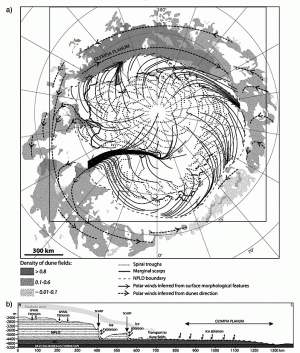The north polar cap of Mars is surrounded by a vast dune field, about as large as Earth’s Kalahari Desert, that contains extensive deposits of gypsum. The gypsum’s origin has been debated since the mineral was discovered in 2005, yet because gypsum crystals are fragile, they must have originated not far from where they now lie.

POWERFUL WINDS come off the ice cap and accelerate down its slopes along the spiral troughs and scarps that cut into the cap. The winds erode the ice, freeing sand, dust, and gypsum from the cap's internal layers and also from the ice- and sediment-rich basal unit. (Image is Figure 7 from the paper.)
A group of geologists led by Marion Massé (Université de Nantes) is proposing (Earth and Planetary Science Letters) that the gypsum comes from two source areas: the so-called basal unit that underlies the entire polar cap, and layers of sediments embedded within the ice cap.
The team writes, “Previous work has suggested that gypsum crystals trapped in the north polar cap formed initially by weathering of dust particles, either in the atmosphere prior to their deposition during the formation of the ice cap, and/or in the ice cap after their deposition.”
The polar cap lies in the lowest part of the northern topographic basin, the scientists note. The cap is 1,300 kilometers (750 miles) in diameter and reaches a maximum thickness of 3 km (2 mi) at its center. The whole ice cap formed during the Amazonian (the last 2.8 billion years), and its upper (younger) parts form a stack of water-ice layers mixed with varying amounts of dust and sand. The layers result from cycles of climatic change.
Lying under the ice cap and extending a distance beyond it lies a dark formation roughly a kilometer thick named the basal unit. It contains sequences of ice- and sediment-rich layers.
The scientists examined the mineral composition of the dune fields around the ice cap using data from the OMEGA and CRISM imaging spectrometers. They found that while the gypsum is especially prevalent in the Olympia Planum area, the mineral lies everywhere in the circumpolar dune field.
Next they examined wind patterns over and around the polar ice. Winds descend over the ice cap and spread outward, following scarps and troughs which they have eroded into the ice cap. The winds cause the ice to sublimate, releasing sediments caught in the ice and transporting them outward into the dune field. The basal unit responds the same way and releases its sediments as well.
Of the two sources for gypsum, the scientists find that the basal unit, being richer in dust, sand, and sediment, contributes the most. As the scientists explain, the intensity of the gypsum spectral bands decreases as the distance from the basal unit increases. “This suggests that the basal unit is the major source of gypsum for the dunes.”








